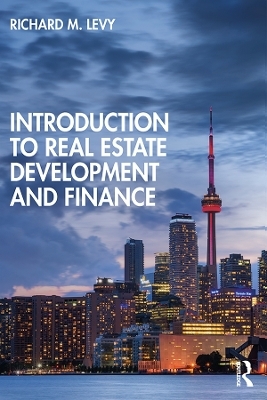
Introduction to Real Estate Development and Finance
Routledge (Verlag)
978-1-138-60245-8 (ISBN)
All development projects fall under the auspices of one or several jurisdictions. Though every jurisdiction has different rules and procedures, basic knowledge of the planning process is critical to the success of all development projects regardless of location. Furthermore, all projects have a legal component. Basic issues of land ownership, property rights, property transfer, and land registration are reviewed, all of which need to be considered when a property is sold or purchased. This book also provides a primary on the design and construction process. In constructing a building, a team of experts is first required to design the architectural, structural, and heating, ventilation, and air conditioning (HVAC) systems for a building. An overview is provided of each building system: wood, concrete, and steel. Critical to a successful real estate development, project management principles for the processes of design, bidding, and construction are explored, with close attention given to budgeting, scheduling, and resource management. Essential reading for anyone involved in the development of our built environment, this is a must-read introduction for students and professionals in architecture, urban planning, engineering or real estate seeking an approachable and broad view of real estate development and finance.
Richard Levy, M.Arch, PhD, was formerly Professor of Planning at the University of Calgary, Canada, where he taught courses in urban planning and real estate development for 26 years. He currently teaches in the College of Business at the University of Rhode Island.
Table of Contents
Preface
Organization of this Book
Chapter 1: Introduction to Real Estate Development and Finance
What is Real Estate?
What Determines Value?
Learning from History
Boom Bust Economies
When Communities are in Decline
The Road to Recovery
Too Much of a Good Thing
The Two Big Questions in Real Estate Development
Supply Side of the Equation
Supply Constraints
Geographical Constraints on Supply
Zoning, Bylaws and other Planning Controls
The Case of the Unreasonable Seller
The Case for Climate Change
The Demand Side of the Equation
The Demographics of Urban Development
Demand and Supply in a Changing Technological Landscape
Financial Factors
Lending
Measuring Demand
Competitiveness
Building the Team
Chapter 2: An Introduction to Financial Analysis
Risk and Reward
Risk Free Rate
Measuring Return
Sharpe Ratio
After Tax Rates of Return
Proforma
Cash Flow, Profit and Loss.
Income
Expenses
Rates of Return
Debt
Borrower and Lender
Loan Mechanics
Debt, Depreciation and Cash flow Statement
Leverage
Balance Sheets
Assets and Liabilities
Cautions
Chapter 3: Model Building and Real Estate Development
Models and Decision Making
What is a Model?
Issues in Model Building: The Practice of Model Building
Model Building and Statistics
Data and Curve fitting: When relationships are Non-linear
Appraisal Models
Dynamic Models
Two Big Questions in Real Estate Development
Spatial Modeling of Land Values
Gravity Models and Retail
Transportation Modeling
Urban Land Use Models
Building Models and the Need for Data, A Practical Approach
Conclusions
Chapter 4: Financial Modeling
Introduction
Cap Rates
Time Value of Money
Net Present Value and Internal Rate of Return
Applying Theory to Practice
Sensitivity Analysis
Case Study – Multi-Family Development: The Value of Forecasting
Scenario1: Business as Usual
Scenario 2: Optimistic Projection
Scenario 3: Level property values.
Scenario 4: Sudden Decline in Property Values
Scenario 5: Sudden Decline in Property Values with no Recovery
Scenario 6: Reinvestment in the Property from Excess Cash Flow
Scenario 7: Negative Return
Scenario 8: Negative return, accompanied by a reduction of mortgage rates
Summary and Conclusions
Chapter 5: Marketing Analysis
Market Analysis: Supply, Demand, and Geography
Market Study and the Real Estate Development Process
Concept development
Design and Marketing
Marketing Studies, Planners and Government officials
Investors and Lenders
Buyers and Tenants
Role of Consultants
Market Research: Basic Principles and Techniques
Market Area: Drawing the Boundaries
Residual Demand
Population Projection and Cohort Models
Demand, Affordability and Residential Development
Case Study: Condo Apartment Development
Introduction
Site and Location
Demographics
Competition
Residual Demand Estimates
Creating a Marketing Program
Retail
Commercial Office Space
Clients and Landlords
Summary and Conclusion
Chapter 6: The Planning Process
The Planning Process
Introduction
Getting Started
Land Use Control, A Brief History
Zoning Defined
Zoning is Never Perfect
What is Wrong with Zoning?
Architectural Guidelines and Historic districts
Americans with Disabilities Act
Subdivisions
Planning Process: Getting to a Successful Conclusion
Hiring a Consultant
Enlisting the Media
Case Study: Inner City Development Project
Background
Site
Development Options
Scenario Evaluation: Design Review
Step 1: First Meeting with Planners
Step 2: Second Meeting, Bringing the Architect into the Process
Step 3: Review of the Development Application
Step 4: Review of the Revised Proposal
Step 5: Meeting the Community
Step 6: Second Revised Plans
Step 7: Meeting the Community to Review the Revised Plans
Step 8: Project Revaluation
Step 9:.Starting Over?
Lessons Learned
Chapter 7: Real Estate and the Law
Introduction
Foundations and Principles of Private Property
The law and Real Estates: Statues, Common Law and Regulations
Collective Ownership of Property
Right of Use
What is a Fixture?
Water Rights
Mineral Rights
Air Rights
Forms of Ownership
Fee Simple or Fee Simple Absolute
Life Estate
Co-ownership
Joint tenancy with right of survivorship
Tenancy in Common
Community Property
Tenancy by Entirety
Condominium
Cooperatives
Ownership and the Investment Community
Sole Proprietorships
Partnerships
Ventures
Corporations
Limited Liability Partnerships
Limited Liability Companies
S Corporations
Real Estate Investment Trusts (REIT)
Real Estate Transactions, Agents and brokers
Mortgages
Secondary Market
Construction Loans
Real Estate Closings, Land title and Registration
Trasnfer of Property
Land Registration
Leases
Eviction
Construction Contracts
Chapter 8: Design and Construction
A Team of Experts
Site Planning, Massing and Space Planning
Mastering the Art and Science of Construction
Technology and the Modern Building
Building from the Ground Up
Foundation Design
Structural Systems
Structural Systems: Concrete, Steel or Wood
Wood Construction
Concrete
Steel
Exotic Structures
Historic Restoration and Preservation Projects
Heating, Cooling and other Building Systems
Managing the Design Process
Chapter 9: Project Management
Introduction: Why do I need Project Management Skills?
Time, Budget and Performance
Project Management Defined
Application of Project Management to Real Estate Development
Bidding Process
Design/Build: A Different Approach
Construction Phase
Scheduling and Resource Management
Project management Teminology
Network Analysis
Lags and Network Analysis
Gantt Charts
Project Management Software
Project Management with Microsoft Project: Renovation of an Office Building
Crashing a Project
Project Evaluation and Control
Earned Value Management (EVM)
Project Termination
Index
| Erscheinungsdatum | 26.11.2019 |
|---|---|
| Zusatzinfo | 24 Tables, black and white; 70 Line drawings, black and white; 21 Halftones, black and white |
| Verlagsort | London |
| Sprache | englisch |
| Maße | 174 x 246 mm |
| Gewicht | 542 g |
| Themenwelt | Naturwissenschaften ► Biologie ► Ökologie / Naturschutz |
| Naturwissenschaften ► Geowissenschaften ► Geografie / Kartografie | |
| Technik ► Bauwesen | |
| Wirtschaft ► Betriebswirtschaft / Management ► Rechnungswesen / Bilanzen | |
| Betriebswirtschaft / Management ► Spezielle Betriebswirtschaftslehre ► Immobilienwirtschaft | |
| Wirtschaft ► Volkswirtschaftslehre | |
| ISBN-10 | 1-138-60245-0 / 1138602450 |
| ISBN-13 | 978-1-138-60245-8 / 9781138602458 |
| Zustand | Neuware |
| Informationen gemäß Produktsicherheitsverordnung (GPSR) | |
| Haben Sie eine Frage zum Produkt? |
aus dem Bereich


